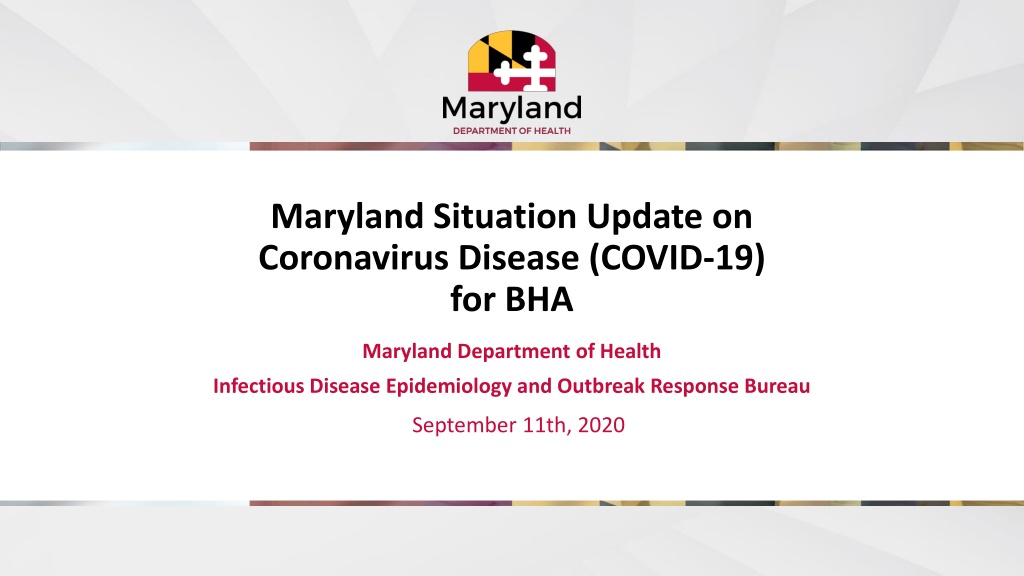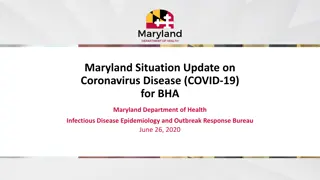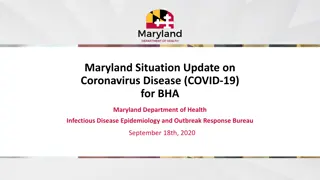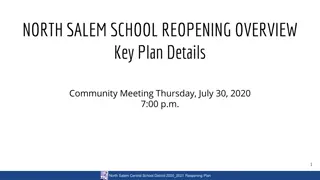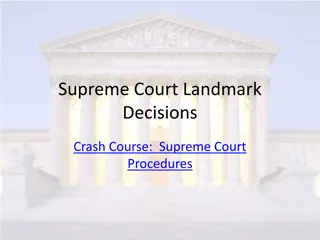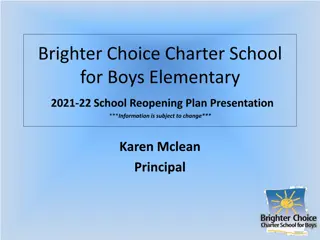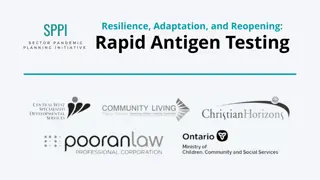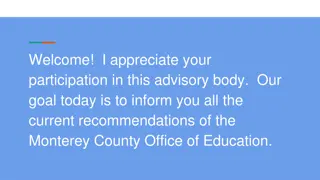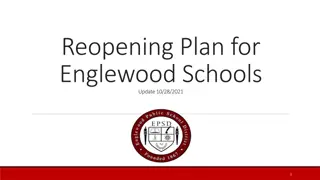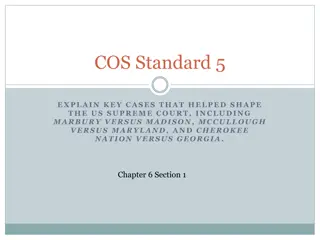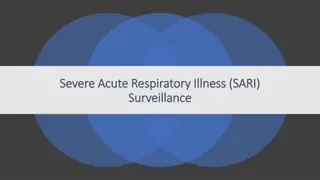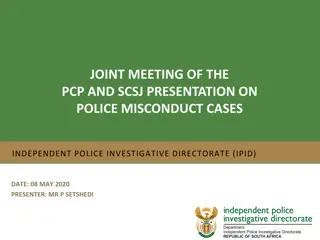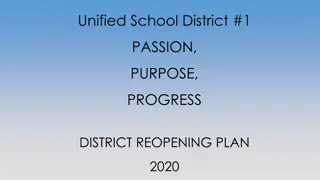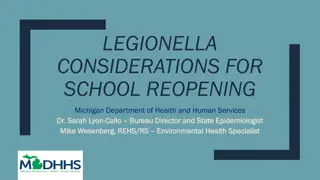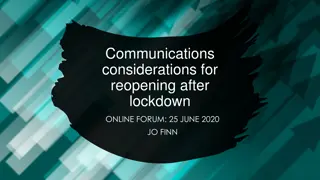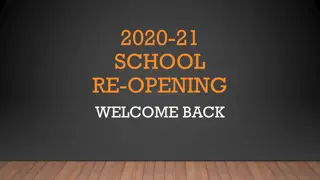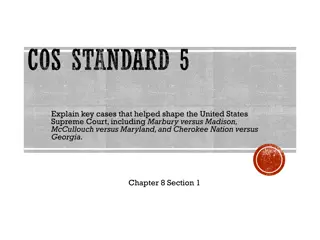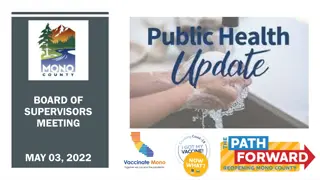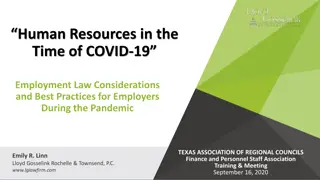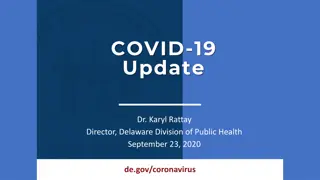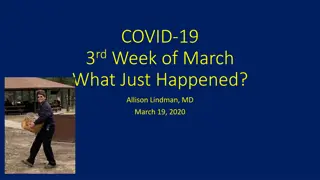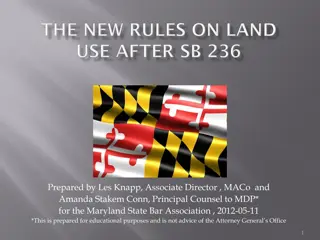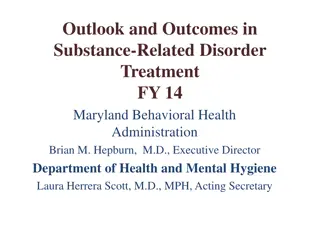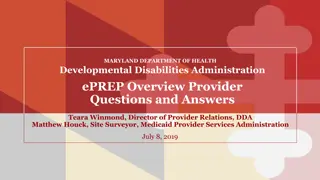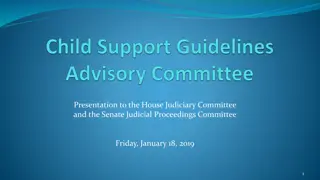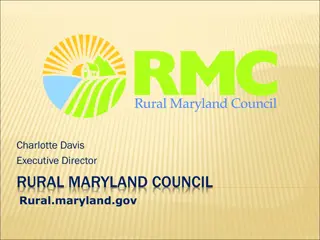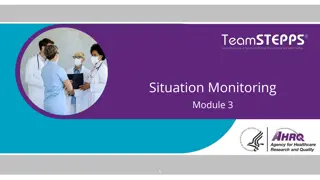Maryland COVID-19 Update: Situation, Cases, and Reopening Stage 3
Maryland's latest COVID-19 update includes 114,724 cases, 3,685 deaths, and 14,184 hospitalizations. Governor Hogan has announced the entry into stage 3 of reopening, allowing indoor theaters and outdoor venues to operate at reduced capacities. Retail and religious facilities can now increase capacity to 75%. Testing volume and positivity rates are also highlighted in the report.
Download Presentation

Please find below an Image/Link to download the presentation.
The content on the website is provided AS IS for your information and personal use only. It may not be sold, licensed, or shared on other websites without obtaining consent from the author. Download presentation by click this link. If you encounter any issues during the download, it is possible that the publisher has removed the file from their server.
E N D
Presentation Transcript
Maryland Situation Update on Coronavirus Disease (COVID-19) for BHA Maryland Department of Health Infectious Disease Epidemiology and Outbreak Response Bureau September 11th, 2020
Call Agenda Picture Courtesy of NIAID-RML Review current situation of COVID-19 Addressing COVID fatigue Flu Vaccine Questions and Answers 2
U.S.: COVID-19 Cases 4 https://www.cdc.gov/coronavirus/2019-ncov/cases-updates/cases-in-us.html Accessed 9/11/2020
http://health.maryland.gov/coronavirus Data current as of 9/11/2020 Maryland: COVID-19 Cases Cases: 114,724 646 new Deaths: 3,685 6 new Hospitalizations: 14,184 Current: 369 50 new Total tests 2,150,638 6
Stage 3 of Maryland reopening June 10th Governor Hogan announced that Maryland will begin entry into stage 3 of reopening. INDOOR THEATERS may open to the general public at 50% capacity, or 100 people per auditorium whichever is less with appropriate health and safety protocols in place. OUTDOOR VENUES may open to the general public at 50% capacity, or 250 people whichever is less with appropriate health and safety protocols in place. RETAIL AND RELIGIOUS FACILITIES. Capacity for retail establishments and religious facilities may increase from 50 to 75 percent. https://governor.maryland.gov/2020/09/01/governor-hogan- announces-beginning-of-stage-three-of-marylands-covid-19- recovery-additional-safe-and-gradual-reopenings/ 12
Maryland Reopening Status Source: https://governor.maryland.gov/recovery/, Accessed September 8, 2020 13
School Guidance Update September 1, 2020 14
New Schools Guidance Additional school guidance documents: Response to a Laboratory Confirmed Case of COVID-19 and Persons with COVID-19-like Illness in Schools - UPDATED Guidance for Temperature and Symptom Screening in Schools - NEW Use of Cloth Face Coverings in Schools UPDATED All of these documents can be found at https://coronavirus.maryland.gov/pages/school- resources 15
Decision Aid Attachment Decision Aid: Exclusion and Return for Laboratory Confirmed COVID-19 Cases and Persons with COVID-19-like Illness in Schools, Child Care Programs, and Youth Camps For the purposes of this decision aid, COVID-19-like illness is defined as: Any 1 of the following: cough, shortness of breath, difficulty breathing, new loss of taste or smell, OR At least 2 of the following: fever of 100.4o or higher (measured or subjective), chills or shaking chills, muscle aches, sore throat, headache, nausea or vomiting, diarrhea, fatigue, and congestion or runny nose. Decision Aid: Exclusion and Return for Laboratory Confirmed COVID-19 Cases and Persons with COVID-19-like Illness in School, Child Care Programs, and Youth Camps Exclude person and allow return when symptoms have improved, no fever for at least 24 hours without fever-reducing medication, AND criteria in the Communicable Diseases Summary have been met as applicable. If person develops symptoms of COVID-19-like illness, follow processes below for person with COVID-19-like illness. Person (child, care provider, educator, other staff) with 1 new symptom not meeting the definition of COVID-19-like illness. The asymptomatic person should stay home for 10 days from positive test. Close contacts should stay home for 14 days from the date of last exposure even if they have no symptoms or they have a negative COVID-19 test done during quarantine. An asymptomatic person (child, care provider, educator, other staff) who tests positive for COVID-19. Person has positive test for COVID-19. Person (child, care provider, educator, other staff) with COVID-19-like illness: The ill person should stay home at least 10 days since symptoms first appeared AND until no fever for at least 24 hours without fever-reducing medication AND improvement of other symptoms. Person does not receive a laboratory test or another specific diagnosis (e.g. influenza, strep throat, otitis) by their health care provider. Exclude person and recommend that they talk to their health care provider about testing for COVID-19 or whether there is another specific diagnosis. The person should isolate pending test results or evaluation by their health care provider. Close contacts of the ill person should quarantine per CDC guidelines. The ill person should stay home until symptoms have improved, no fever for at least 24 hours without fever- reducing medication, AND criteria in the Communicable Diseases Summary have been met as applicable. Close contactsDO NOT need to stay home as long as they remain asymptomatic. Person has negative test for COVID-19. Health care provider documents that the person has another specific diagnosis (e.g. influenza, strep throat, otitis) or health care provider documents that symptoms are related to a pre-existing condition. The person should consider being tested/retested for COVID-19 if symptoms do not improve. Attachment for document entitled, Response to a Laboratory Confirmed Case of COVID-19 and Persons with COVID-19-like Illness in Schools August 28, 2020 16
UPDATED - COVID-19-like Illness definition For the purposes of this decision aid, COVID-19-like illness is defined as: Any 1 of the following: cough, shortness of breath, difficulty breathing, new loss of taste or smell, OR At least 2 of the following: fever of 100.4o or higher (measured or subjective), chills or shaking chills, muscle aches, sore throat, headache, nausea or vomiting, diarrhea, fatigue, and congestion or runny nose. 17
Influenza Vaccination Flu shots are now available at doctors offices, pharmacies, urgent cares, etc CDC recommends that everyone over 6 months old gets a flu vaccine Talk with your healthcare provider about which vaccine is best for you Best timing is in September and October It is never too late to get a flu shot https://www.cdc.gov/flu/prevent/keyfacts.htm 18
COVID Fatigue As the pandemic goes on, it gets harder to remember to maintain a heightened awareness of the need for precautions At the beginning, fear, hypervigilance, novelty, constant messaging, kept many people engaged in prevention efforts Most people can not maintain that level of intense engagement Especially people who have not been directly impacted People more likely to maintain precautions: know someone who got COVID got COVID themselves lost someone to COVID (work in public health) 19
How to Fight COVID Fatigue Commit to behavior change Keep up with the science using reliable news sources Be flexible when the science changes the recommendations Make a new habit Keep supplies handy and available If you need motivation, read a story from someone directly impacted https://www.hopkinsmedicine.org/health/conditions-and-diseases/coronavirus/how-to-deal- with-coronavirus-burnout-and-pandemic-fatigue 20
Behavior Changes from Public Health This disease is not going away anytime soon, but we can make changes in behavior: Seatbelt use Car seats Bike helmets Safer sex No smoking in public places One day soon: universal correct mask use 21
Resources MDH Novel Coronavirus: http://health.maryland.gov/coronavirus MDH Laboratory Coronavirus: https://health.maryland.gov/laboratories/Pages/Novel- Coronavirus.aspx COVID-19 People at risk https://www.cdc.gov/coronavirus/2019-ncov/specific-groups/high- risk-complications.html CDC Guidance for Infection Control https://www.cdc.gov/coronavirus/2019-nCoV/infection- control.html Behavioral Health https://www.cdc.gov/coronavirus/2019- ncov/hcp/infection-control- faq.html?CDC_AA_refVal=https%3A%2F%2Fwww.cdc.gov%2Fcoron avirus%2F2019-ncov%2Finfection-control%2Finfection-prevention- control-faq.html Memory Care https://www.cdc.gov/coronavirus/2019- ncov/hcp/memory-care.html 22
Questions? Email : mdh.ipcovid@Maryland.gov 23
